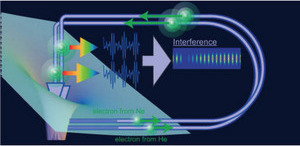Jul. 20, 2007 Research Highlight Physics / Astronomy
Boosting the harmonics of light–matter interaction
Researchers show that the interaction of a laser pulse with a mix of two gases creates high-energy radiation
 Figure 1: The steps leading to higher harmonics generation. A high-intensity laser pulse tears electrons away from the helium and neon atoms. After a short time, the electrons are driven back to the atom, where they are recaptured. The electrons then release short pulses of high-energy radiation that interfere with each other, creating a spectrum of high harmonic frequencies. © 2007 by the American Physical Society
Figure 1: The steps leading to higher harmonics generation. A high-intensity laser pulse tears electrons away from the helium and neon atoms. After a short time, the electrons are driven back to the atom, where they are recaptured. The electrons then release short pulses of high-energy radiation that interfere with each other, creating a spectrum of high harmonic frequencies. © 2007 by the American Physical Society
A team of researchers from the RIKEN Discovery Research Institute in Wako has shown that the strong light–matter interaction between a short laser pulse and a mix of the two noble gases helium (He) and neon (Ne) can be used to create laser pulses with very high energies and extremely short duration.
Laser light can be described as an oscillating electric and magnetic field. These intense fields, particularly for very short and powerful pulses, can exert significant forces on atoms: forces strong enough to separate and eject an electron from its atom. However, this ‘excursion’ is only short-lived as the electromagnetic field of the laser beam oscillates rapidly. Therefore, after a short time, the laser field changes its direction and pushes the electron back towards the atom (Fig. 1) where it is recaptured. The electron then releases its energy as a short, intense laser pulse having a harmonic frequency that is a multiple of the original laser frequency.
This process of ‘higher harmonics frequency generation’ occurs for both types of atoms in the gaseous mix. As helium and neon have slightly different electronic properties, the harmonics generated by these two atoms differ slightly in energy so interact with each other in a process known as interference. Crucially, interference leads to conditions that “not only allow the determination of the oscillation phase of the generated harmonics but also enable us to see the motion of the electrons and atoms,” explains Tsuneto Kanai from the RIKEN team. These findings were published recently in the journal Physical Review Letters1.
The team observed excursion times as low as a few hundred attoseconds—the shortest duration of a particle motion observed to date: an attosecond is one billionth of one billionth of a second. Such short pulse durations of the higher harmonics create exciting possibilities for further studies, particularly as the relative mixture of the two noble gases provides the means to tune the energy and intensity of the generated harmonic radiation.
Kanai is therefore convinced that “this new light source will provide us with new insights into fundamental processes in nature and their possible use for applications.” For example, it will allow the study of the molecular dynamics in gases with attosecond resolution. More complex mixtures of molecules might lead to further improvements. Therefore, this pioneering work marks only the beginning of an entirely new research field.
References
- 1. Kanai, T., Takahashi, E. J., Nabekawa, Y. & Midorikawa, K. Destructive interference during high harmonic generation in mixed gases. Physical Review Letters 98, 153904 (2007). doi: 10.1103/PhysRevLett.98.153904
